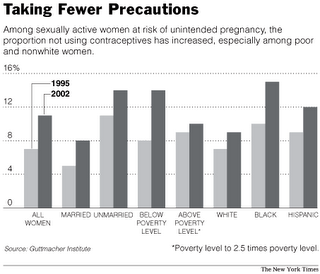Abstinence Only? To Arms! Send in the Shag Troopers!
Tim Kreider was inspired by the NYT's Contra-contraception article. Be sure to read the Artist's Statement in the link below the cartoon.
What You Can Do To Fight Against The War on Sex!
Tim Kreider was inspired by the NYT's Contra-contraception article. Be sure to read the Artist's Statement in the link below the cartoon.
What You Can Do To Fight Against The War on Sex!
Despite my best efforts to keep the popular press at bay, shouting headlines cannot always be avoided. Over the past few weeks I have placed the pieces together and have arrived at the conclusion that, apparently, the greatest threat facing our country today is hordes of gay Mexicans wishing to illegally cross our borders so that they can lobby to get married, use all of our oil, and demand that our schools teach evolution. This will, of course, signal the "end times". I imagine that somewhere there is a bible code that predicts this and that an hour long special about it will be broadcast soon on the History Channel.
Remember, you read it here first.

Oh, the sweet tales of Peter Rabbit! I fondly recall reading Beatrix Potter's stories to my kids when they were small imps. Old Mrs. Rabbit patiently and lovingly tended to her baby bunnies, Flopsy, Mopsy, Cottontail and that young rascal, Peter. She was a model of motherly behavior which included the threat of disaster should her bunnies stray too far afield:
'Now, my dears,' said old Mrs. Rabbit one morning, 'you may go into the fields or down the lane, but don't go into Mr. McGregor's garden: your Father had an accident there; he was put in a pie by Mrs. McGregor.'
Oh, mothers! Dear noble, selfless, tender and ferocious defenders of progeny all across nature's phylogeny: How well you deserve our admiration as Mother's Day draws near, and how photogenically you grace the greeting cards that we thrifty offspring will send in lieu of a proper gift.
Here is a mother guinea hen, trailed by a dozen cotton-ball chicks. Here a mother panda and a baby panda share a stalk of bamboo, while over there, a great black eagle dam carries food to her waiting young. We love you, Mom, you're our port in the storm. You alone help clip Mother Nature's bloodstained claws.
But wait. That guinea hen is walking awfully fast. In fact, her brood cannot quite keep up with her, and by the end of the day, whoops, only two chicks still straggle behind. And the mama panda, did she not give birth to twins? So why did just one little panda emerge from her den? As for the African black eagle, her nest is less a Hallmark poem than an Edgar Allan Poe. The mother has gathered prey in abundance, and has hyrax carcasses to spare. Yet she feeds only one of her two eaglets, then stands by looking bored as the fattened bird repeatedly pecks its starving sibling to death.

We here at the Chimp Refuge have railed on about the Christian Right's incursions into the discipline of evolutionary biology, and their insidious distortions of science in the name of their fundamentalist faith. Their intrusiveness is not limited to the teaching of evolution in public schools. It also extends to public health and an aim to further curtail access to birth control.
While scanning the New York Times last Friday (May 5) this caught my attention: Use of Contraception Drops, Slowing Decline of Abortion Rate. The article focused on a report released last week by the Guttmacher Institute, a "nonprofit organization focused on sexual and reproductive health research, policy analysis and public education."
From the NYT article by Kate Zernike:
Contraception use has declined strikingly over the last decade, particularly among poor women, making them more likely to get pregnant unintentionally and to have abortions, according to a report released yesterday by the Guttmacher Institute.
The decline appears to have slowed the reduction in the national abortion rate that began in the mid-1980's.
"This is turning back the clock on all the gains women have made in recent decades," Sharon L. Camp, the president of the institute, said.

The researchers blamed reductions in federally and state-financed family planning programs for declining contraceptive use. They called for public and private insurance to cover contraceptives, and for over-the-counter access to the so-called morning-after pill, which can prevent pregnancy if taken within 72 hours after sex.

First hand experience with butchering pigs seems to be de rigeur these days. I stumbled across two recently published articles which followed the general theme of colorful Italian teaches squeamish urban American how to gut a hog.
The first, Carnal Knowledge - How I became a Tuscan butcher by Bill Buford, New Yorker 05/01/2006, begins by the author's procurement of a pig (freshly deceased) from the Greenmarket in NYC. With the pig precariously tied to his Vespa, Buford careens through the streets to his home in Manhattan where he butchers the animal in his kitchen. After this preamble, he describes his tutelage from experienced butchers in a Tuscan macelleria where nearly every bit of the hog is put to culinary use.
The second was an excerpt in the NYT Sunday Magazine, The Modern Hunter-Gatherer, from Michael Pollan's new book, The Omnivore's Dilemma. An interview with Pollan appeared in in the UCal-Berkeley News. Based on reviews and this interview, The Omnivore's Dilemma has reached the top of my reading list. In the spirit of Fast Food Nation, Pollan's book scrutinizes the sources and economics of our food as modern consumers. As part of his explorations, he prepared a dinner for friends from scratch, and I do mean from scratch. Pork was the main course so Pollan set off into the California brush, accompanied by the requisite grizzled Italian hunter, to bag a wild boar for dinner.
Pollan's description of the hunt is nicely crafted. Likewise, Buford's chronicles of his apprenticeship to the maestro macellaio evoke the central place of meat in the Tuscan diet and culture. Buford is less squeamish about the whole business than Pollan is. As a former farm kid, and current omnivore, it was with perplexed bemusement that I read Pollan's occasionally reverential, occasionally anguished scrutiny of first-hand killing of a food animal.
Killing animals for food was a fact of life on the farm. I regularly witnessed poultry beheadings then I looked on as my mother plucked the hen and disembowled it. I was fascinated by the entrails of the birds. As a kid, I saw a steer gutted and cleaned at the local butcher's operation, the "locker" as we called it. I knew the source of my meat-based food and likely, I had even named the animal. The cattle and chickens lived well on our farm. We only kept four or five steers and/or heifers grazing in our pasture at any given time. They also ate cracked corn as a treat. They were contented beasts which lived in a healthy environment. Similarly, the chickens roamed freely around our orchard. We respected the animals, and I felt a detached affection for them. They weren't pets, hence the detachment, but they were living breathing mammals and birds whose lives intertwined with mine.
For some time, I cynically regarded my memory of our delicious, full flavored farm-raised beef and chicken as superior food as a merely nostalgic view through rose-colored glasses. Now, I realize our farm raised meat really was that much better. For quite some time, I kept the image of our free ranging animals lazing about on a small farm at the fore and pushed the reality of crowded feedlots as the source of my steaks, burgers, and roasts to a dusty corner of my cerebral cortex. But Fast Food Nation really did me in. The prospect of cattle eating the offal of their own kind in the form of meal is revolting, not to mention the deplorable conditions of the feedlot and the workplace for the humans slaughtering the animals.
I am fortunate that I have the luxury of being pretty free with my grocery money and to live in an area where I have a wide range of choices in food markets. So, I usually aim toward Whole Foods as the market where I purchase most meat and poultry. The conditions for animals and workers of the Whole Foods suppliers may be marginally better than the Big Ag Biz operations. Pollan's term for the supply chain to Whole Foods and the like is "Big Organic." There is an alternative, short of stalking devil deer in the surrounding woods for my dinner. In this part of the Gahduhn State, there are several small farming operations which cattle, pigs, sheep and poultry and sell the meat as organic. Cherry Grove Farm is an example, and their beef tastes very much like what I remember as a youth. Cherry Grove is an example of what Pollan terms a pastoral food chain. Fewer animals are raised. They roam freely and eat a lot of grass. In fact, these farms are reminiscent of my childhood home. Although I have yet to read the book, Pollan's comments in the NYT Magazine article lead me to believe this is a far more sustainable kind of agriculture, and certainly more humane for the animals.
Back to the fascination which Pollan and Buford appear to have with butchery...Many of us, er, older biochemists are not phased by blood and guts. When I first entered the pharma biz after my post-doc, I worked with enzymes which I isolated from porcine kidneys and bovine adrenal glands. This was quite a transition after working with recombinant enzymes which were expressed in and purified from E. coli. Although my then-employer had some pockets of scientists cloning genes and expressing the corresponding proteins, there was no centralized group which provided these, so most of us biochemists were on our own when we had to find sources for enzymes and receptors. There were a couple of slaughterhouses in the city . I chose to patronize the smaller one. The butchers smirked when I entered the killing floor since they expected me, a young suburban woman, to be squeamish. A guy pointed out a smaller carcass hanging in the locker and told me that it was a German Shepherd. Without missing a beat I replied "Sheep" with a smile. I never flinched as I watched their operation, and finally, one of the guys astutely guessed that I was a farm kid.
Over the course of the year, I popped in to harvest kidneys and adrenals. The guys brought the animals down in a swift and sure manner using a captive bolt. I never witnessed the animals struggle. It was like turning off a switch. The evisceration process was contained and efficient. Copious washes of scalding water were used to keep the area sanitary. When the animal was gutted and hanging, I climbed a small stepladder placed in front of the carcass and dug my bare hands into the back of the body cavity to scoop out the adrenals or cut out the kidneys. That winter, my hands and forearms were exceedingly soft. I wasn't using any extra skin lotion so I wasn't sure why this was until I realized that my moisturizing regimen was supplemented by wallowing in back fat.